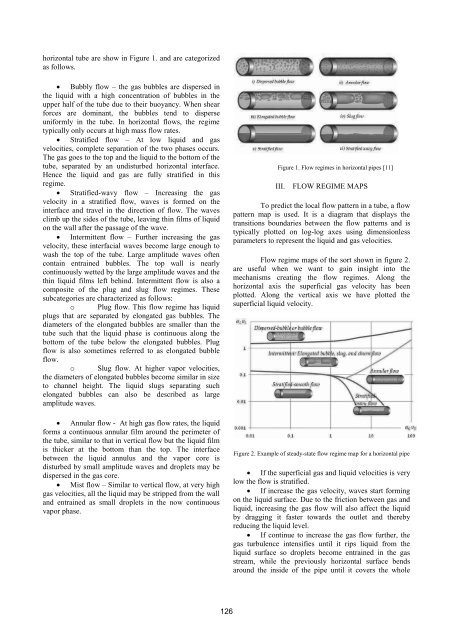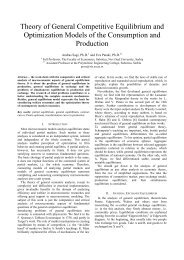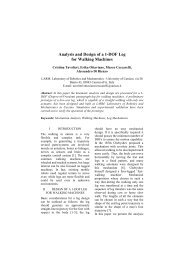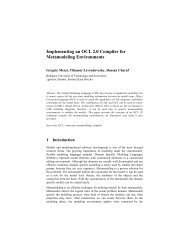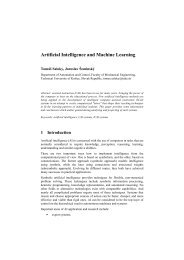Final Program EXPRES 2012 - Conferences
Final Program EXPRES 2012 - Conferences
Final Program EXPRES 2012 - Conferences
- No tags were found...
Create successful ePaper yourself
Turn your PDF publications into a flip-book with our unique Google optimized e-Paper software.
horizontal tube are show in Figure 1. and are categorizedas follows. Bubbly flow – the gas bubbles are dispersed inthe liquid with a high concentration of bubbles in theupper half of the tube due to their buoyancy. When shearforces are dominant, the bubbles tend to disperseuniformly in the tube. In horizontal flows, the regimetypically only occurs at high mass flow rates. Stratified flow – At low liquid and gasvelocities, complete separation of the two phases occurs.The gas goes to the top and the liquid to the bottom of thetube, separated by an undisturbed horizontal interface.Hence the liquid and gas are fully stratified in thisregime. Stratified-wavy flow – Increasing the gasvelocity in a stratified flow, waves is formed on theinterface and travel in the direction of flow. The wavesclimb up the sides of the tube, leaving thin films of liquidon the wall after the passage of the wave. Intermittent flow – Further increasing the gasvelocity, these interfacial waves become large enough towash the top of the tube. Large amplitude waves oftencontain entrained bubbles. The top wall is nearlycontinuously wetted by the large amplitude waves and thethin liquid films left behind. Intermittent flow is also acomposite of the plug and slug flow regimes. Thesesubcategories are characterized as follows:o Plug flow. This flow regime has liquidplugs that are separated by elongated gas bubbles. Thediameters of the elongated bubbles are smaller than thetube such that the liquid phase is continuous along thebottom of the tube below the elongated bubbles. Plugflow is also sometimes referred to as elongated bubbleflow.o Slug flow. At higher vapor velocities,the diameters of elongated bubbles become similar in sizeto channel height. The liquid slugs separating suchelongated bubbles can also be described as largeamplitude waves. Annular flow - At high gas flow rates, the liquidforms a continuous annular film around the perimeter ofthe tube, similar to that in vertical flow but the liquid filmis thicker at the bottom than the top. The interfacebetween the liquid annulus and the vapor core isdisturbed by small amplitude waves and droplets may bedispersed in the gas core. Mist flow – Similar to vertical flow, at very highgas velocities, all the liquid may be stripped from the walland entrained as small droplets in the now continuousvapor phase.Figure 1. Flow regimes in horizontal pipes [11]III.FLOW REGIME MAPSTo predict the local flow pattern in a tube, a flowpattern map is used. It is a diagram that displays thetransitions boundaries between the flow patterns and istypically plotted on log-log axes using dimensionlessparameters to represent the liquid and gas velocities.Flow regime maps of the sort shown in figure 2.are useful when we want to gain insight into themechanisms creating the flow regimes. Along thehorizontal axis the superficial gas velocity has beenplotted. Along the vertical axis we have plotted thesuperficial liquid velocity.Figure 2. Example of steady-state flow regime map for a horizontal pipe If the superficial gas and liquid velocities is verylow the flow is stratified. If increase the gas velocity, waves start formingon the liquid surface. Due to the friction between gas andliquid, increasing the gas flow will also affect the liquidby dragging it faster towards the outlet and therebyreducing the liquid level. If continue to increase the gas flow further, thegas turbulence intensifies until it rips liquid from theliquid surface so droplets become entrained in the gasstream, while the previously horizontal surface bendsaround the inside of the pipe until it covers the whole126


